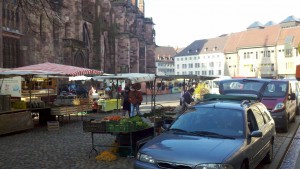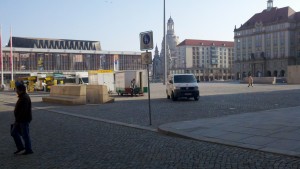A little over three years ago, for the first time since 1986, I returned to the area of Germany that had been the Sowjetische Besatzungszone (the Soviet Occupation Zone), more tongue-in-cheek identified for just over 40 years as the German Democratic Republic. Back then I’d visited Leipzig, Dresden, and of course East Berlin. I still remember being struck by the evidence, everywhere visible to someone with his eyes open, of decay and degeneration. Just for example, I recall a railroad bridge over a street in Leipzig. It wasn’t a very wide street, and the bridge was one of your basic-model beam girder bridges with tracks over the top. It had obviously not been painted in decades. Huge areas of advanced rust, scrolls of peeling paint. Everywhere you looked there was filth, ancient, undisturbed filth. Oh sure, in the designated public places things were more or less clean. East Berlin was always a show-place, but even there once you got away from the main drags, the places where tourists were expected, it was the same old story: neglect and decay.
Back in 2010 I learned that they’d re-built the Frauenkirche in Dresden, and since the last time I’d seen it the church was a thirty-plus foot tall pile of rubble I decided I had to go. So I rode the train over. I like riding on trains. Trains go past people’s back yards. Driving past the front door, you see the polished door knob, the carefully-groomed plantings, the nice lace curtains. Around back you get to see what they do with their garbage, broken tools and toys, and derelict equipment.
They’ve long since ripped out the border fences, mine fields, watchtowers, and so forth. You can still quite distinctly tell, though, when you’ve crossed from what used to be West Germany over into the former SBZ. You see, over in the western part of the country, when they’ve got to leave something outside, they stack it neatly, stretch a tarpaulin over it, and lash it down. You won’t see equipment just left out in the elements. If a building is running down, they’ll either fix it just as good as it was, or they’ll tear it down and build something new. You’ll never see a boarded-over window, or a sagging roof line, or a sheet of metal tacked over a hole in the roof. Weed-overgrown places are foreign to the scenery. You see all that and more in the old East Germany.
Dresden is the capital city of Saxony. Saxony was one of the four kingdoms which existed under the old Kaiserreich, the others being Prussia, Bavaria, and Württemberg. They had their own army (subordinated to the Kaiser’s command in wartime, to be sure, but very much with its own culture and command structure). The capital city was famous the world over for its art, its music, and its architecture. The Frauenkirche was just one of a large number of breathtakingly beautiful public structures. It was, in short, not just some provincial burgh. It’s actually large enough that it had, and has, not one but two market places. The Altmarkt, or Old Market, is just that, the original market area within the old walls. It was and remains the main market. The Neumarkt, or New Market, was outside the original city walls, and it’s where they built the “new” Frauenkirche from 1726-43. Large areas of it are still construction site, 70 years after the war (you can see in the open excavations the foundations of the old buildings in the neighborhood; after the firestorm there wasn’t much to do but bury them, cobble over, and go on with life).
So I was struck when walking past the Altmarkt at about 7:45 a.m. on a weekday morning. At that hour the markets in just about every other German town of any size at all will be absolute beehives of activity. Vendors will be setting up, the early shoppers will be nosing about, and there will be a steady stream of new arrivals to buy and sell. This, for example, is the south side of the market square in Freiburg, a small university town, at about 6:45 a.m. on a weekday morning:
By 8:00 a.m. all you’ll be able to see beyond the cars in the foreground is a sea of canopies of vendors, and swarms and swarms of people.
This, in contrast, is the Dresden Altmarkt at about 7:45 a.m:
That’s it. That’s all. This is what private enterprise looks like, 21 years after reunification. Stunted.
We have two nearly perfect laboratories to compare the corrosive effects of socialism on the peoples it is inflicted upon. One is the two Koreas. Both were a unitary society for centuries. Both experienced the tender ministrations of Imperial Japan. Both experienced the scourge of war from 1950-53. For 60+ years now, the north has been communistic, and the south has not. Mind you, until the last generation or so, even the south was ruled by authoritarian governments. So really any difference in how they live has had maybe 30 or so years to manifest itself.
The other laboratory was Germany. For 45 years you had two societies that had been one for centuries. They’d both experienced the 30 Years War, the Napoleonic conquests, the wars of unification, the First World War, hyperinflation and the terrors of the Weimar fiasco, the heady days of Nazi triumphalism, and the devastation of the war to eradicate it. The only difference, for 45 years, was that one people lived under capitalism, however watered down, and the other under socialism.
It appears, now, that their physical world isn’t the only thing that corroded, that it isn’t only their entrepreneurial spirit that is stunted. Their morality seems to have taken a hit, too. Here at The Economist we have a report of a study done on several hundred Berliners. What they found was a pretty clear correlation between not just whether someone had lived in the old East Germany and how willing they were to lie for pecuniary gain, but between the degree of that willingness and how long they’d been exposed to it. Very briefly, the longer someone had lived under that system, the more readily they lied for money.
The next time someone starts yapping about supposedly immoral capitalism, trot that study out. These results back up what I have long said: The central wickedness of socialism — of all collectivist systems, in fact — is that it destroys humans’ moral agency. If every aspect of your life is the subject of direct compulsion by the state, then you can be neither virtuous nor iniquitous. And if you can be neither, you rapidly lose the ability to distinguish between the two. In fact, you rapidly lose the sensibility that they are two different things. Capitalism permits immorality; that much has to be conceded. But it is only because you may be wicked under capitalism that you are capable of virtue, at all.


